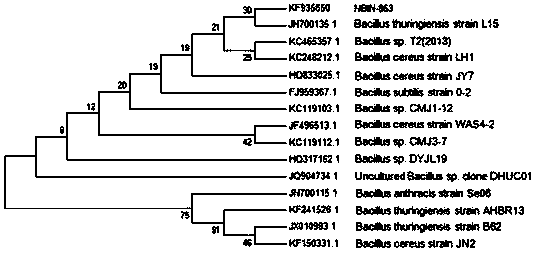Bacillus thuringiensis for killing meloidogyn incognita and culture method of bacillus thuringiensis
A technology of root-knot nematode incognita and Bacillus chrysogenum, applied in the direction of nematicides, microbial-based methods, biochemical equipment and methods, etc., can solve problems such as polluting the environment
- Summary
- Abstract
- Description
- Claims
- Application Information
AI Technical Summary
Problems solved by technology
Method used
Image
Examples
Embodiment Construction
[0019] Bacillus thuringiensis strain Bacillus thuringiensis NBIN-863 that kills root-knot nematode incognita, depository unit: China Collection Center for Type Cultures, address: China, Wuhan, Wuhan University, collection center number CCTCC NO: M2013612, deposit date: November 27, 2013 Date, date of survival: November 29, 2013.
[0020] Morphology of the Bacillus thuringiensis strain that kills root-knot nematode incognita: the single colony grown on the plate is milky white snowflake-like, with a rough surface, and it is rod-shaped under the electron microscope after 24 hours of growth. After 36 hours of growth, it becomes unstained spores and stained spores Rhombic crystals; 6 proteins were produced in the supernatant after 48 hours of growth, 3 of which were insecticidal crystal proteins, namely Cry9Aa protein (130kDa), Cry2Aa protein (69kDa) and Cry1Ac protein (130kDa) ( image 3 ). Bacillus thuringiensis has activity against M. incognita.
[0021] On May 10, 2012, the ...
PUM
| Property | Measurement | Unit |
|---|---|---|
| molecular weight | aaaaa | aaaaa |
Abstract
Description
Claims
Application Information
 Login to View More
Login to View More - R&D
- Intellectual Property
- Life Sciences
- Materials
- Tech Scout
- Unparalleled Data Quality
- Higher Quality Content
- 60% Fewer Hallucinations
Browse by: Latest US Patents, China's latest patents, Technical Efficacy Thesaurus, Application Domain, Technology Topic, Popular Technical Reports.
© 2025 PatSnap. All rights reserved.Legal|Privacy policy|Modern Slavery Act Transparency Statement|Sitemap|About US| Contact US: help@patsnap.com



